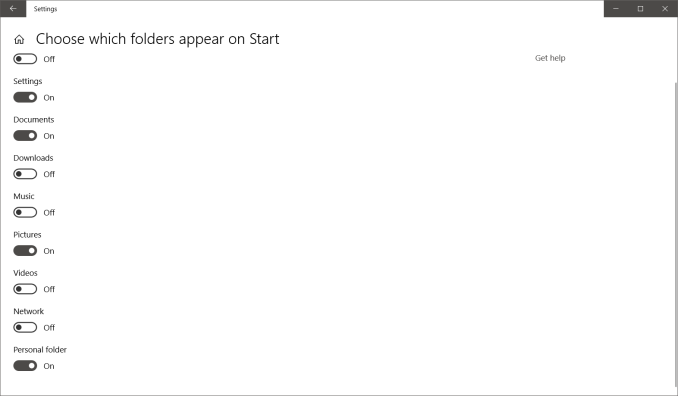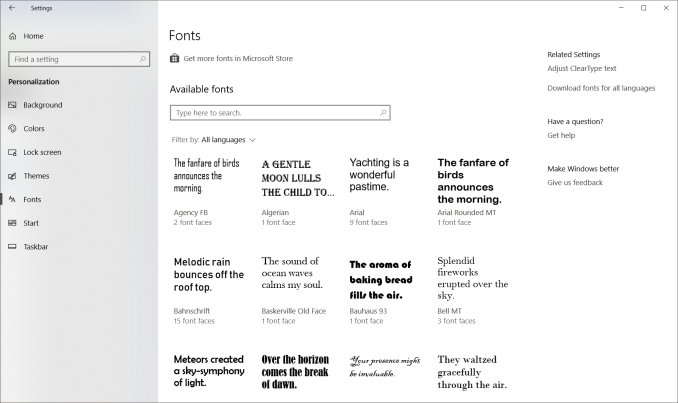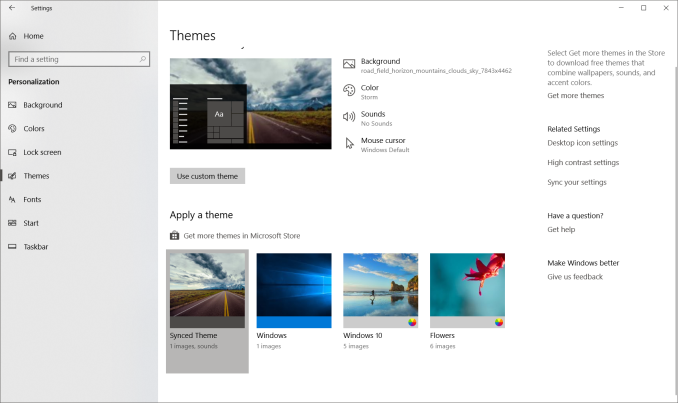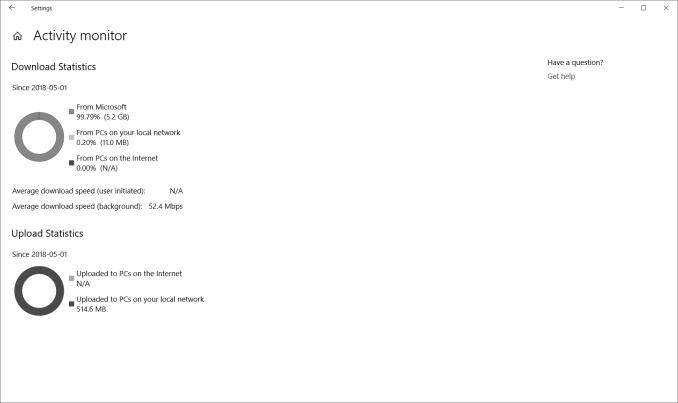The Windows 10 April Update (1803): The Littlest Big Update
by Brett Howse on May 25, 2018 8:00 AM EST- Posted in
- Software
- Operating Systems
- Windows
- Microsoft
- Windows 10
Design Tweaks: More Fluent, New Features
Microsoft’s new design language for Windows 10 is Fluent Design, which they first announced at Build 2017, and first seen in the Fall Creators Update which shipped at the end of 2017. Fluent Design is based on the five concepts of light, depth, motion, material, and scale, and we saw several glimpses of this with the previous update.
For the April Update, Fluent is now much more integrated into all experiences with the OS. On the Start Menu, for instance, there’s a lot more use of lighting to track where the mouse is. It not only looks fantastic, it’s also more usable. This carries into the title bar of apps as well, and coupled with the acrylic blurring effects, keeps the OS looking fresh and modern.
Speaking of the Start Menu, it’s a subtle change, but there’s now shortcuts to documents and photos on the left side of the menu, by the Settings icon. And what’s more, this list can be customized to include or remove File Explorer, Settings, Documents, Downloads, Music, Pictures, Videos, Network, and the Personal Folder - which goes to Users\<username> - and each has their own unique icon. This is a nice setting to quickly get to where you often need to go in the file explorer. It would be nice to be able to add your own folders here though, or at least customize the ones that exist now. If you use your OneDrive photos folder, for instance, the photos shortcut can’t be changed to that, which is a shame.
Another small tweak is you can access an app’s settings page by right clicking it in the Start Menu. That’s handy, but if you have it pinned on your task bar, that doesn’t work, so it would be nice to see more consistency in how the right click menu works.
Settings Changes: Moving Away From Control Panel, and Increased Privacy Options
When Windows 10 first launched, it kept the old Control Panel from Windows 8 and previous versions intact, and easily accessible, since many of the settings still had to be configured through it. Over the years, more and more features are being moved from the legacy Control Panel to modern Settings panels. This is sometimes a mixed blessing. The entire Settings is searchable, so it’s often much easier to find obscure things you might need to tweak, but at the same time, functionality can sometimes be removed during the transition to make it cleaner.
Fonts
With the April Update, one of the oldest settings ever still in Windows has finally been updated: Fonts. The interface to install Fonts in previous versions of Windows was literally right out of Windows 95 era, but now it’s all modern, fresh, and fluent. Fonts can be installed either by using a TTF file, or through the Store, and Fonts can be removed through Settings.
Themes – Microsoft Plus! For Windows 10
Windows 10 now supports themes in the Store, and can be installed and managed through Settings. Hooray!
New Update Options
Microsoft has somewhat backed away from its very annoying policy when Windows 10 first launched, where the system would just randomly decide you weren’t busy, and reboot for updates, even if you were right in the middle of something, and the last couple of updates have added notifications and scheduling options. They still want everyone to be patched, but the latest update is less intrusive here.
You’ll get notifications when updates require a restart, and you can easily schedule a time right in the notification. In addition, big feature updates like the April Update should install quicker than before. This has been an ongoing project though, and hopefully improvements will continue.
This came with the previous update and we didn’t notice it, but you can finally set how much bandwidth is allocated for updates, and set how much upload bandwidth you’ll allocate for updating PCs on the internet, and cap how much you upload. On a shared network with a less than amazing internet connection, one PC that checks for updates can kill the internet connection for everyone, so this is very welcome.
You can also monitor the download statistics for updates, and see how much of your updates are coming from Microsoft, as compared to machines on your network, or PCs on the internet if you have that enabled for some crazy reason.
New Privacy Options
Microsoft has taken a more aggressive default option on telemetry with Windows 10. They want to own the experience with Windows, so if a device driver is crashing PCs, telemetry would let them know anonymously that a device is causing issues, and they can work with the vendor to get a driver update created.
This is exactly how a mobile OS works, of course, but it’s not something we’ve been accustomed to with the PC. Telemetry has been a thing for a while, but there’s no doubt that Windows 10 had very lax default policies to ensure it was enabled for most users.
This has rankled some customers though. They want to know what is being collected, or turn it off completely. You still can’t turn it off completely, but with the April Update, there’s now a way to view your diagnostic data, and to delete the data on the PC. Microsoft now offers a free Diagnostic Data Viewer in the Store which lets you view everything that’s collected.
















161 Comments
View All Comments
haplo602 - Monday, May 28, 2018 - link
Update itself went fine, however Tablet Mode stopped working after update. I have a convertible laptop (HP Envy x360). When I flip he device into tablet mode, screen rotation kicks in, keyboard and touchpad get disabled but no prompt to switch to tablet mode, when I set the option to not ask and switch, still nothing. I can only switch manually via action center.ಬುಲ್ವಿಂಕಲ್ ಜೆ ಮೂಸ್ - Monday, May 28, 2018 - link
That's hilariousSometimes I think they should replace "Saturday Night Live" with "Comedy Hour Updates"
It would be very entertaining to see all the most obnoxious, dastardly, destructive and moronic "updates" Microsoft has to offer on a weekly basis
Typo - Monday, May 28, 2018 - link
only 1/3 of the computers in my house has gotten the update. Neither of my laptops seem to see it yet.ChristopherFortineux - Friday, June 8, 2018 - link
Laptops usually get pushed back in the update scheme.pjcamp - Monday, May 28, 2018 - link
I'd give all that up for the ability to put a live tile on the desktop. I use a third party app to keep Windows 7 gadgets running because a calendar reminder isn't very useful if I have to remind myself to open the start menu to see it.lmcd - Monday, May 28, 2018 - link
This is a good look at the update for the consumer "Home" SKU, which many users are using. However, for me personally this is single-handedly the best update Windows 10 has had. This update adds two excellent features for developers.For Android Developers, this release launches the Windows Hypervisor platform, which allows for the Xamarin version of the Android Virtual Device Manager to run with Hyper-V enabled (or, more specifically, with Docker for Windows enabled).
Yes, the Xamarin AVD version is still in Beta. No, your rebuttals cannot be heard over the sound of my rejoicing.
For C++ Windows developers, this release adds C++/WinRT, which removes a lot of the constraints around consuming UWP APIs from C++ code, and adds support for UWP CLI tools.
While I haven't explored exactly what the latter does yet, I believe (along with the current UWP API surface area improvements) that the ChakraCore-derived version of Node + NPM could be completely packaged as UWP apps for system-wide use.
draknon - Tuesday, May 29, 2018 - link
Microsoft was nice enough to return the edge shortcut to my desktop. I guess they thought I may have accidently deleted it (it wasn't on accident). Also, they changed the audio options when you right click on the speaker icon in the task bar. I used to be able to go directly to the playback/recording devices from here. But now, the only option is to choose sounds and then click over to the playback tab afterwards. It's another step which gets annoying.elopescardozo - Tuesday, May 29, 2018 - link
I was contacted by a friend that after the upgrade to 1803, his Excel would crash at the first attempt to enter something in a cell. Turns out that this is a known feature : 1803 kills several older Excel versions. Apparently. Microsoft is not planning to repair this. It is either incredibly sloppy programming or a malicious way to force people to upgrade their Microsoft Office. Is this how they recuperate the "free" OS updates?Personally, I hate the way to "simplify" Windows by making active controls unrecognizable: links in the settings menue are generally gray without any indication that they are clickable. Someone should explain that a workstation is not a telephone or a tablet end never will be.
ChristopherFortineux - Friday, June 8, 2018 - link
Product is End of Life. But the issue is 'Security Update for Microsoft Excel 2002 (KB2541003)'t.s - Tuesday, May 29, 2018 - link
One feature that android (on and off) and linux have that windows and mac/ios doesn't have: dark theme/mode. It would be nice too, if ms edge have inverse color that chrome has (extensions).